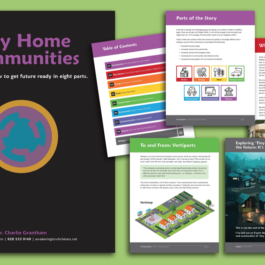What are the top 10 trends for the next ten years? Download the report here.

Image credit: Samuel Velasco/Quanta Magazine
It’s easy to predict the future when things are stable, certain, simple, and clear. The prediction goes something like this: tomorrow will be exactly like today.
Rinse. Repeat.
No one lives in that world.
We live in a VUCA world
“VUCA” is an acronym for volatility, uncertainty, complexity, and ambiguity. VUCA was originally developed by the US Army War College in the late 1980s to describe conditions after the end of the Cold War. It came into common use after 9/11.
Futurists use VUCA to address the uncertainty that’s implicit in nearly every organization and community.
We wish the world was: | The world is actually: |
|
|
|
|
|
|
|
|
In the example below, we’ll apply VUCA to cryptocurrency, and then show how you can apply this approach to your organization or community.
VUCA X Crypto
We’ll use a 12-box table to break cryptocurrencies down into each of the VUCA characteristics.
[Why did we choose crypto? We believe it - and decentralized finance - are examples of a larger trend towards decentralization of socio-economic systems including supply chains.]
Volatility | Uncertainty | Complexity | Ambiguity | |
Feature | Value fluctuates based on consensus of ‘coin’ holders | The upper bound to the number of coins is unknown due to lack of centralized issuing authority | The number of types of ‘coins’ increases and there is no stable exchange mechanism | There is no regulatory authority and the risk of investment is unquantifiable |
Example | Bitcoin moved over a 50% +/- range (2019-21) | Number of currencies increase 150% (2021-22) | 380 available currently | Nine countries including China and Russia have banned cryptos |
Action | Develop alternative best case/worst case scenarios with triggers | Establish a monitoring ‘dashboard’ | Include an international financial analyst on your planning staff | Scan regulatory and legal systems on a routine basis |
How can I apply VUCA in my community, system, or organization?
Select an issue, trend, or domain that is experiencing turbulence.
Create a 12-box table like the one above and map the volatility, uncertainty, complexity, and ambiguity across the features, examples, and actions. Here are some questions to help you fill in the boxes:
Feature: How is this VUCA factor featured or demonstrated in your chosen topic? What is driving this factor to be present?
Example: What is a concrete example for this factor in your topic? Where and how is it relevant to your organization, network, or community?
Action: What might be some approaches for your organization, network, or community to address this specific factor?
Why is VUCA analysis useful?
It helps clarify how much is known about the issue, trend, or domain. Knowing what you know and what you don’t is incredibly valuable for avoiding blind spots, the black ice of planning.
It helps you brainstorm a range of potential actions or solutions. This helps you move from “passive victim” to “informed change-agent.”
Can I base my strategic plan directly on this kind of VUCA analysis?
We don’t recommend this. VUCA is more like a SWOT (strengths, weaknesses, opportunities, threats) analysis – a good starting point for some components of strategic planning but insufficient for an entire organization’s or community’s plan.
Should I use VUCA in place of scenarios?
VUCA analysis can offer valuable input for scenario planning, e.g., deciding the scope of scenarios and particular types of challenges and opportunities to explore, but VUCA is not a substitute for scenarios.
How do VUCA and scenarios relate to each other?
If you’re experienced in scenarios, your leadership team or subject matter experts may consider questions like:
What may be the most likely future for how the four VUCA factors unfold in your community or industry? How might potential solutions be implemented? What might be their most likely intended and unintended implications or impact?
What could go wrong? How might the four VUCA factors generate even more challenges for your community or industry? Where and how might the implementation of potential solutions backfire or fall short?
In a visionary or “surprisingly successful” future, how might the VUCA factors unfold? What would it look like when the right things happened in the right ways?
Have you done a VUCA analysis of an issue facing your community or organization?
Where and how might the VUCA 12-Box help you pursue brighter futures?
If you enjoyed this post, please subscribe to our newsletter.

Charlie Grantham
Charlie Grantham, PhD, APF is a futurist, author, and strategist who’s helped dozens of our clients over the years. Charlie served in Special Forces in Vietnam and earned his PhD in Sociology. Afterwards, he worked on the front lines of the telecommunications and remote work revolutions. He’s seen a thing or two. His current focus is health care and well being. Charlie works from Tucson, AZ.

Yasemin Arikan
Yasemin (Yas) Arikan operates the research vessel. She is a futurist who uses foresight and social science methods to help clients understand how the future could be different from today and then use these insights to inform strategy and vision. Her work includes developing scenarios on the futures of public health, health care, society and technology for associations, foundations, government, and business. Bonus: Yas can help you take your gift wrapping game to the next level. And she can talk with you about it in English, German, or Turkish. Watch Yas' Q&A on how NGC helps organizations prepare for the future using Strategic Foresight.
Yasemin Arikan Promoted to Director of Futures Research
NEXT Generation Consulting (NGC) announced the promotion of Yasemin Arikan to Director of Futures Research. Arikan will lead the company’s efforts to...
Is Your Housing Market Ready for Your Future?
One of the biggest problems facing many cities and towns is inadequate housing. This problem is most acute for seniors, veterans with disabilities, and low-income groups ...
Three Things Martha Stewart Gets Right About Return to Office (RTO)
The original influencer and the person who invented the "Home" retail category, Martha Stewart, became the latest CEO to tell employees to get back to the office five day...







